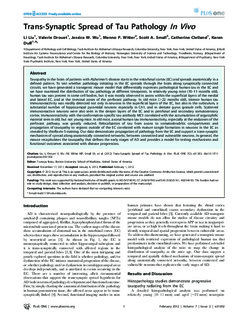| dc.description.abstract | Tauopathy in the brain of patients with Alzheimer’s disease starts in the entorhinal cortex (EC) and spreads anatomically in a
defined pattern. To test whether pathology initiating in the EC spreads through the brain along synaptically connected
circuits, we have generated a transgenic mouse model that differentially expresses pathological human tau in the EC and
we have examined the distribution of tau pathology at different timepoints. In relatively young mice (10–11 months old),
human tau was present in some cell bodies, but it was mostly observed in axons within the superficial layers of the medial
and lateral EC, and at the terminal zones of the perforant pathway. In old mice (.22 months old), intense human tau
immunoreactivity was readily detected not only in neurons in the superficial layers of the EC, but also in the subiculum, a
substantial number of hippocampal pyramidal neurons especially in CA1, and in dentate gyrus granule cells. Scattered
immunoreactive neurons were also seen in the deeper layers of the EC and in perirhinal and secondary somatosensory
cortex. Immunoreactivity with the conformation-specific tau antibody MC1 correlated with the accumulation of argyrophilic
material seen in old, but not young mice. In old mice, axonal human tau immunoreactivity, especially at the endzones of the
perforant pathway, was greatly reduced. Relocalization of tau from axons to somatodendritic compartments and
propagation of tauopathy to regions outside of the EC correlated with mature tangle formation in neurons in the EC as
revealed by thioflavin-S staining. Our data demonstrate propagation of pathology from the EC and support a trans-synaptic
mechanism of spread along anatomically connected networks, between connected and vulnerable neurons. In general, the
mouse recapitulates the tauopathy that defines the early stages of AD and provides a model for testing mechanisms and
functional outcomes associated with disease progression. | nb_NO |
